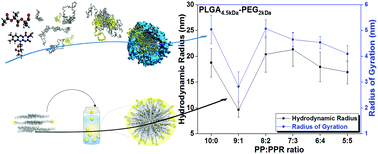An insight into the role of riboflavin ligand in the self-assembly of poly(lactic-co-glycolic acid)-based nanoparticles – a molecular simulation and experimental approach†
Abstract
Nanoparticles (NPs) used for targeted delivery purposes are rapidly gaining importance in diagnostic and therapeutic fields. These agents have been studied extensively so far to reveal their optimal physicochemical properties including the effects of ligands and their density on the surface of NPs. This article was conducted through a computational approach (all-atom molecular dynamics simulations) to predict the stability of NPs based on a poly-lactic-co-glycolic acid (PLGA) hydrophobic core with a poly-ethylene glycol (PEG) hydrophilic shell and varying numbers of riboflavin (RF) molecules as ligands. Depending on the molecular weight of the polymers, the most stable composition of NPs was achieved at 20 wt% and 10 wt% PLGA–PEG–RF for PLGA3kDa–PEG2kDa and PLGA4.5kDa–PEG2kDa polymers, respectively. According to the simulations, riboflavin molecules were located on the surface of the NPs, which would indicate that riboflavin-bound PLGA–PEG NPs could be efficiently utilized for active targeting purposes. To scrutinize the simulation results, NPs with riboflavin ligands were synthesized and put into in vitro experiments. Outstandingly, the empirical outcomes revealed that the hydrodynamic sizes of NPs also met minimum points at 20 and 10 wt% for PLGA3kDa–PEG2kDa and PLGA4.5kDa–PEG2kDa, respectively. Moreover, similar trends in the gyration radius as a function of riboflavin content were observed in the simulation analysis and the experimental results, which would indicate that the method of molecular dynamics (MD) simulation is a reliable mathematical technique and could be applied for predicting the physicochemical properties of NPs.

- This article is part of the themed collection: Soft Matter Most Popular 2020


 Please wait while we load your content...
Please wait while we load your content...